Eurail Passes are famous as a way to save money while exploring Europe, but they are also confusing and often misunderstood. They are still an amazing money-saving tool for certain types of travelers, and not a wise idea for most others. Before Europe introduced dynamic rail pricing (like airfares, where the price varies depending on when you buy it), a Eurail Pass was an easy way to save money since all tickets had fixed prices that were generally fairly expensive. These days most travelers can save far more money just by buying their train tickets at least a few weeks in advance.
That said, Eurail Passes are still great for longer trips and especially for people who like to make plans as they go. Dynamic rail pricing made advanced tickets much cheaper, but it also made last-minute tickets MUCH more expensive. Below we will discuss Eurail Passes and whether they are a good idea for your trip or not.
Disclosure: This is a reader-supported website and some of the links are affiliate links where a small commission is paid to help keep this site going.
Note: This article was written in 2012 and has been continuously updated since then, so all information is current as of April, 2024.
Eurail 2024 changes: New countries and a mobile version
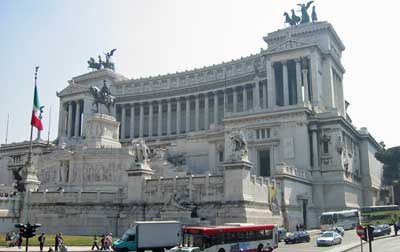
Aside from that it’s just the normal fact that they have updated the timetables as of December 2023 and have a few promotions going on, but those usually don’t happen over the busy summer season.
Eurail passes are now available in a mobile version
Until very recently, Eurail Passes were only available in paper form and they were quite confusing at first. You’d get a pass with a series of empty boxes on it and you’d need to enter your trip before you’d use your pass each day and then have the first conductor verify it. If you lost your ticket (and this was not uncommon), it was a whole ordeal to attempt to get a replacement.
Again in 2024 Eurail offers a fully mobile version that is delivered instantly to your mobile device with no delivery fee. And if you somehow lose your phone, you can resume using your Pass on your replacement with no extra headache. This is MUCH more convenient in every way and as long as you can keep track of your phone you’ll always have your train pass handy.
If your trip will be 2 weeks or less, a Eurail Pass probably won't be worth it

Eurail Passes are ideal for travelers on longer trips, and especially those who don’t want to plan all of their destinations and dates far in advance. If you have your itinerary pretty much planned out and you don’t require much flexibility, you’ll be far better off just locking in your dates and buying your train tickets as early as you can. Again, they can be surprisingly cheap if you buy 2 to 4 months out.
If you are age 27 or younger, a Eurail Pass is probably worth it

With this in mind, if you are lucky enough to still be 27 or younger, you should seriously think about getting a Eurail Global Pass Youth, partly because the sense of freedom instantly gets more expensive at age 28. The age cutoff was 25 until recently, so this change is a great deal for anyone who will be 26 or 27 at the start of their trip.
You aren’t guaranteed to save money by buying a Youth Eurail Pass, but chances are good that you WILL save money and you’ll definitely save a lot of hassle as well. Especially now that Eurail Passes come in a mobile form, it’s even that much more convenient to just hop aboard any train that is about to leave the station and not worry about buying or even having a ticket. Especially for young people, it can be really fun and exhilarating to literally just walk into a train station with your backpack and look at the departure board and then decide where to go at that moment.
If you are age 60 or over, a Eurail Pass could also be great value
Another fairly recent change is that anyone who is 60 years or older at the start of the use of a Eurail Pass now gets 10% off the normal adult fare. That new discount is going to make this a great value for many travelers who might have been on the fence about buying a full-price pass before.
>>>Check prices on Eurail Passes
If you are planning on traveling in 1st Class anyway, a Eurail Pass is probably worth it
Most 2nd Class trains provide similar comfort and legroom to Business Class airline seats, or at least close enough, so for most people it’s not worth the added expense for 1st Class. However, if you are rich or elderly or fear contact with strangers, a 1st Class Eurail Pass is probably worth it no matter what.
Not only do you get much more comfort and legroom in 1st Class, with only 3 seats across instead of 4, but there is another advantage to 1st Class on European trains. Since it’s mostly business travelers and wealthy people traveling in 1st Class, the carriages are almost always mostly empty except in the mornings and late afternoons between large cities. In 2nd Class the only available seats might be two seats in an 8-seat cabin with all the other seats taken up by a loud family or a group of rowdy friends. In 1st Class you are all but guaranteed a peaceful ride, and usually plenty of empty seats from which to choose.
A hidden Eurail Pass benefit: Making extra stops on travel days for free
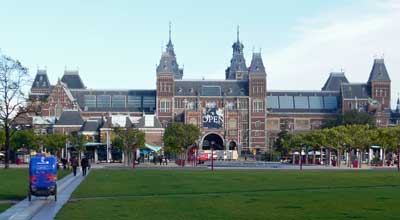
Brussels in particular is one I recommend a short stop in because the small historic center around what they called the Grand Place is amazing and gorgeous, while the rest of the city is rather boring by European standards. With a Eurail Pass you can jump off the train in Brussels and explore the city center for a few hours (luggage storage is cheap and easy) and maybe have lunch, and then hop on a later train to complete your journey to Amsterdam. There are opportunities like this on many if not most trips between larger cities, and if you buy the point-to-point tickets you have to stay on the train you booked.
Another example is the high-speed train between Barcelona and Madrid, which takes about 2.5 to 3 hours in each direction. There are some interesting cities in between, but in this case you could take a morning train from Barcelona to Madrid and then check into your accommodation, and then hop on another train from Madrid to Toledo, which takes about 30 minutes and costs €14 each way. Toledo is a historic and fascinating town, but it’s also pretty small and you can explore the main sights in an afternoon. With a Flexi Eurail Pass where you buy a certain number of travel days, you can save more money by adding on these sorts of nearby stops on travel days.
If you'll be touring major cities within ONE country, a single-country pass might be perfect, and Second Class passes are available for all ages
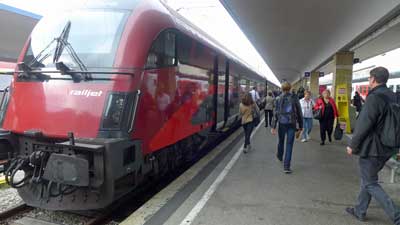
Single-country passes are still available and they MIGHT be good value for you, but it depends on which country and how much traveling you’ll be doing. If you plan on going all over a larger country such as Germany, France, or Spain, and especially if you like to make plans as you go, a Single-country pass for one of those might be your best deal. On the other hand, smaller countries (such as the Netherlands) or countries where train tickets are already fairly cheap (such as Italy) might be harder to get value out of. Long story short, for single-country passes you really need to check fares of the places you plan on going and see how they add up compared to the pass.
>>>Check prices for Single Country Passes
Eurostar (between London and Paris or Brussels or Amsterdam) tickets are now included for Eurail Pass holders for a €30 reservation fee
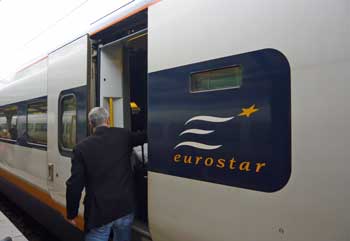
Our recent tests show that Eurostar fares one-way from London to Paris can be as low as €49 if you book about 3 months out, or as expensive as €214 for the same seat if you wait until the day of travel to buy. Round-trip/return tickets can be even cheaper if there is a promotion running.
>>>Check Eurostar prices
If you are on a really low budget, a Eurail Pass isn't a good idea
Here’s the thing. As we’ll discuss below, there are many potential benefits to Eurail Passes, and they will often save you money, but they do cost a lot and they only really save you money when traveling in the more expensive countries.
So let’s say you have a flight to Rome and then US$2,000 to last you a month after you arrive. Buying a Eurail Pass before you go would help you see a lot in that month, but you’d practically need to sleep in parks for your funds to last the whole time. You’d be better off moving slowly in the southern countries, or just in Italy itself, as a way to have the best holiday on your budget. You might also be tempted to use a Eurail Pass mostly on night trains so you can save the cost of a hotel or hostel, but those aren’t ideal for most of us.
The cheapest way to get around Europe by rail is to buy all train tickets online at least a couple months in advance. The fares are low, but they are non-refundable and non-changeable. See how far in advance you should buy train tickets to get those attractive fares.
If more than a little of your travel will be in eastern Europe, a Eurail Pass isn't a good idea
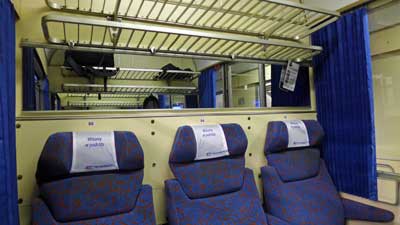
The good news is that the trains operating in this region, and the buses that operate alongside and/or where trains aren’t running, are quite cheap. So if any significant part of your trip will be into this region, a rail pass doesn’t make sense.
Basic types of Eurail Passes
Long gone are the days of the simple options, replaced by specialized passes that are meant to appeal to different styles. It should be pretty easy to figure out which is best for you, and then keep going down the page to decide if it’s worth it at all.
Eurail Global Pass – 4,5, or 7 days within 1 month or 10 days within 2 months
Until recently the minimum number of travel days with 10 days within 2 months, but now you can buy as few as 4 days within 1 month for about €200 to €250 (for first class). This can actually be an interesting strategy if you are planning many shorter and cheaper trips (like within Italy or Eastern Europe), and also 4 or 5 longer trips such as Berlin to Amsterdam. This way you can buy only 4 or 5 travel days and only use them for your most expensive travel days, and just pay as you go or buy cheap advance tickets for your other journeys.
Eurail Global Pass – 15 to 90 consecutive days
This variation allows for unlimited travel on the system for between 15 and 90 total days. They are really only a good idea for people who are certain they are going to travel very often, with much of it being in the north of Europe. The problem with them is that if you really try to get your money’s worth, you will probably ruin your trip by spending too much time on trains in general. On the other hand, if you will be in Europe for 2 or 3 months and plan on traveling around a lot, you can get a LOT of use out of a longer pass. The 3-month pass is around €900 so it’s literally about €10 per day. Imagine going back and forth between Berlin and Munich or Barcelona and Madrid for €10 per day!
One Country Pass
Obviously these are for travel within one country only. Again, they can be great deals if you plan on extensively moving around one particular country.
Where to buy your Eurail Pass
Eurail Passes are cheapest and easiest to buy online, primarily from two main sources which offer all the same products at the exact same prices:
This is a reliable company based in the Netherlands but with fulfillment offices in the US and Ireland. Price of Travel is a partner with this company, and if you use the links of this site we earn a small commission to help keep this site online. Eurail.com is usually cheaper than RailEurope (discussed below) by the way.
They were founded in the 1930s and are based in New York, but owned primarily by the French and Swiss rail companies. They offer free shipping (2 to 3 business days) on all orders of US$399 or more, although now that a mobile version is available, this is meaningless. Price of Travel is a partner with this company, and if you use the links of this site we earn a small commission to help keep this site online.
Reservations on European trains for rail pass holders
For most of the fastest trains between major cities you’ll need to reserve a seat even with a rail pass. It can usually be done just before you leave and the cost is usually around €5. Here’s a full list of which European trains require reservations and which don’t.
Reservations are required on all intercity (longer distance) trains in or involving France, Spain, Switzerland, and Italy. For most trains in Germany, Austria, Netherlands, Belgium, and most of eastern Europe, you can usually find trains that don’t require seat reservations. Often, if you don’t leave until after 9:30am or so, you can ride on any train with no seat reservation, but you have to research each leg to be sure.
How to determine which trains require seat reservations, and also get schedules
You can click on the link just above this section for a list of countries and their seat-reservation policies, but in some cases it’s actually a bit more complicated than that. For example, you can generally ride without a seat reservation on fast ICE (Inter City Express) trains in Germany if you depart after 09:30 in the morning. They do this to free up seats for business travelers who pay full fare, and they don’t mind filling up seats with rail pass holders on trains leaving a bit later.
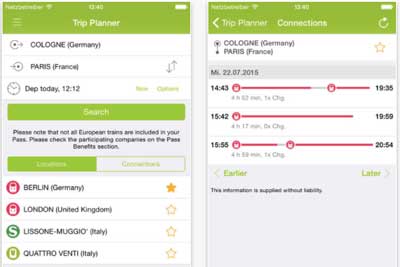
Night trains in Europe are making a comeback
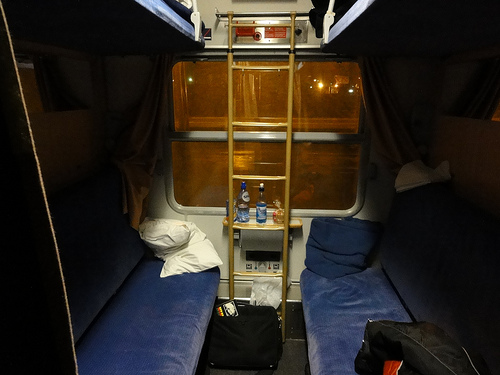
Fast forward to 2024 and night trains are not only expanding service, but they are very trendy. Some of it is nostalgia for the older way of getting around, but most of it is for environmental purposes combined with European hatred for the “low cost airline” experience with RyanAir and Easy Jet etc.
Personally I’m still not a fan of night trains because I find it difficult to sleep on them since they often get decoupled at interim stations in the middle of the night and then coupled onto other trains coming from other places, and I can’t sleep through any of that. But still, they are worth looking into and they are fun to try at least once.
A bit of warning that they tend not to be cheap and even if you have a Eurail Pass you’ll almost certainly want to book a sleeping cabin with a bunk or couchette, and that will come at an extra fee. On the other hand, if you are the sort of person who can sleep sitting upright in a normal seat, then that won’t cost any extra on most overnight trains.
Factors to consider when thinking about any Eurail Pass
Assuming you know which Eurail Saver Pass option is the best one for your type of trip by now, we’ll go over the main factors that should help you decide whether it’s the best idea for you.
Eurail Passes are best for standard ‘medium length’ journeys

However, if you are determined to travel between Rome and Paris, it’s about a 14-hour journey that will almost certainly be overnight. In this case, a cheap plane ticket is probably better, although taking shorter hops on the train is even better, so spend a day or two in Milan or Lyon on the way instead.
And of course, if you prefer to stop in various small towns between the big ones, then a Eurail Pass won’t pay off, except for the traditional kind for unlimited travel in a given period.
Eurail Passes are better value in northern Europe, France, and Spain, and poor value in Italy
Once you do a bit of research you’ll quickly learn that train tickets (and almost everything else) are much more expensive in Germany, Netherlands, Denmark, Sweden, Norway, and Finland than they are in Greece, Italy, Portugal, and Spain. With this in mind, the regional passes can make sense if you are spending time in the south, but the Global Passes almost certainly won’t. Train tickets in Spain used to be fairly cheap, but in recent years they’ve added new high-speed trains between the major cities, and these are quite expensive.
Unlike most other countries, Italy really subsidizes its train tickets so they are quite reasonable even on travel day, and very cheap if you buy a month or more in advance. For example, you can go between Rome and Florence for around €49 if you buy on travel day, and as little as €19 if you buy well in advance. In most other countries, fares are double or triple that much for similar rides.
So consider your planned itinerary. If more than half of it is in the Mediterranean countries then look into a Regional Pass or just buy tickets as you go, because they tend to be pretty cheap. But if you are planning on spending at least half your time in Paris and places to the north of it, then a Eurail Pass is probably a money saver because those tickets are expensive.
Trains are almost always better than planes
Flying sucks, even in Europe
Until you’ve experienced the joy of traveling around Europe by train you might be tempted to “maximize” your time by flying low-cost airlines between each city. This would be a mistake. In order to get truly cheap airfares you have to purchase long in advance, buying non-refundable tickets. You might also have to commit to flights in the very early morning or in the late evening, because cheap tickets on convenient flights sell out quickly.
And again, most European airports are around an hour outside of the city. They are often on the main train lines, which helps, but still you have to deal with the madness of security and also try to get there at least two hours early. From one city center to any other city center it’s about 5 hours minimum, even if they are close, and those are pretty miserable hours.
Train travel is a positive experience

Not only are all the seats comfortable on trains, but you also have an interesting view most of the time. Better still, trains deposit you in the heart of every city, which is usually the neighborhood with the cheapest hotels and food. It’s a wonderful feeling to step off a relaxing train ride, buy a hot dog or sandwich at a local shop, and then be in your hotel room only about 10 minutes later.
Eurail Passes are better than train tickets alone
As someone who enjoys the process of crunching numbers and looking for value, I have to also mention that I’d buy a Eurail Pass even if it seemed like it would cost a bit more than the individual tickets. With a pass you get an extra element of freedom that is worth a lot more than you might expect until you’ve used one.
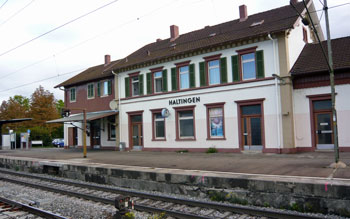
Let’s say you are heading from Amsterdam to Hamburg tomorrow morning. The 09:00 train you planned for might seem a bit ambitious after a long night out, so you can instead opt for the 10:00 or 11:00 train. As long as you walk into Centraal Station 10 or so minutes before departure, you are on. If you are flying you can’t change your ticket, and if you are buying train tickets as you go you have to be in line at the international desk at the train station at least 30 minutes early, and even then you might miss it if they are busy.
Freedom and getting to feel like a big shot
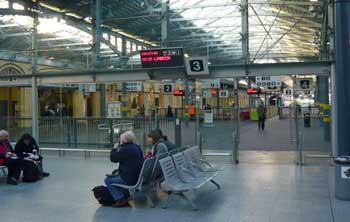
Let’s say you are staying at a hostel in Brussels, and two groups of new friends suggest that you go along with them to their next stops. One group is going to Bruges, which is a short and cheap journey, so you can join them by buying individual tickets (unless you have the unlimited pass, making it free). Then you restart your trip from Bruges, on to your next destination. The other group is headed to Berlin on a night train, which is long and expensive, but with a Eurail Pass you don’t even have to think about the cost. On you go, just like a rich person.
Buying a Eurail Pass is great for those who might run out of money
We all know people who keep meticulous track of every penny they spend, and who are always putting money away for a rainy day. And we all know people who can take a US$100 “entertainment fund” and burn through almost all of it in just a few hours. For the first type of person, a Eurail Pass can help you keep track of expenses, but it’s really the second type of person these are best for.
It’s sad to hear about people who have big plans to see their dream destinations, but they run out of money for transportation halfway into the trip, so they have to just stay put until they fly home. It happens. Locking in your major transportation costs before you leave home, and probably saving money in the process, is a wise move for anyone who isn’t as disciplined as they’d like with their money.
>>>Check prices on Eurail Passes
Bottom line: If you want to keep travel costs down, your choices will usually be a Eurail Pass or buying tickets at least a month or more early
In the last few years, almost every long-distance train ride in Europe has switched to a pricing system similar to low-cost airlines. In other words, tickets go on sale 2 to 6 months ahead of time at very low prices, and they keep getting more expensive as the train fills up and the date approaches. For most trips where a rail pass is possible, this is how things stack up:
Cheapest possible way: Buy advanced (non-refundable, non-changeable) train tickets at least 30 days in advance
Next cheapest way: Buy a Eurail Pass and make seat reservations as you go, usually only a day or less in advance.
Most expensive way: Buy train tickets as you go, or less than a week in advance.
Thinking about it this way should make the choice a bit easier. If you are the type who likes to plan each day and travel segment long before you even leave home, then buy tickets online for the best prices. This can be the best strategy for most shorter trips (10 days or less) because you simply don’t have enough time to change many things as you go anyway.
Buying a Eurail Pass won’t be quite as cheap, but you are buying a LOT of flexibility with the extra money. If you dream of making up your plans as you go, or even making up your plans just a few days in advance, this is almost always your best bet.
But if you wait too long, and just show up looking to buy train tickets as you go, they are going to cost a fortune. As recently as only a few years ago all seats would be the same price on many rail systems, so you could always just wing it. When each country computerized its rail systems so they can sell advanced tickets cheaper, they also had to keep track of seat reservations, so the whole pricing structure had changed to favor advanced ticket buyers and rail pass holders over those who’d prefer to just hop on any train as it is leaving the station.
Have a rail pass or itinerary question of your own?
It wasn’t planned but scores of people began asking me rail pass and itinerary questions at the bottom of this article and a few others. I’m happy to keep answering them and now I’m trying to organize them better as well so they are easier for other people to find.
If you have a question about specific types of European rail passes, please ask it in the comments below.
But if you have a question more about a European itinerary or other non-rail-pass questions, please click over to the European itineraries Q & A article and ask in the comments of that one.

Three adults and 2 children (ages 16 14) Plan to travel from Munich to Augsburg, Munich to Oberammergau, Munich to Dachu, etc. Then we want to go to Venice and Rome. What is the best to go? Euro [ass, Select Pass, German tickets??? Patty
Patty,
Augsburg and Oberammergau are short regional train rides from Munich, so you can buy those when you get there and they will be fairly cheap. Dachau is a suburb of Munich and it’s easiest reached by bus. If you want to visit the concentration camp in Dachau, there is a local bus that drops you right in front.
From Munich to Venice you could take the train and I highly recommend it if you have the time. It takes you through a gorgeous section of the Alps, so do it during the day if you can. Or you could fly to Venice or nearby Treviso and it would also be fairly cheap if you buy in advance. The train tickets will be cheapest if you buy online in advance from bahn.de as well.
From Venice to Rome you’ll take a train, which again is pretty cheap, but cheapest if you buy at least a few weeks in advance. Have a great trip. -Roger
Hi Roger,
Need your advice in selecting a rail pass. Ill be traveling in the month of October and my journey will start from Krakow, Poland to Budapest, Hungary followed by Prague.
From Prague, I will be traveling to Munich, Germany and most probably to Berlin as well. Post which next destination would be a couple of days in Luxembourg. Next stop will be Paris and finally ending my trip at Amsterdam.
Can you please suggest the best way to travel around this itinerary? Also please do let me know the option of Bus travel wherever you think it seems best.
Thanks!
Sumit,
Assuming that you are working with a limited budget, I don’t think a rail pass would be good value for this trip. For your first legs from Krakow to Budapest and to Prague, the trains are pretty cheap and also quite slow. The buses in that area run more frequently and usually have free wi-fi, plus the tickets are even cheaper, usually without having to buy far in advance. Even Prague to Munich might be the same situation in that a bus will be cheaper and almost the same speed.
And if you are going to Berlin, I think I’d do it after Prague and before Munich. A Prague to Berlin bus or train is fairly cheap, but the one from Munich to Berlin would be pretty expensive unless you bought it at least a few days if not longer in advance. From Munich you can take a train to Paris, which will also be expensive unless you buy at least a few days in advance.
From Paris you can take a fast train to Luxembourg City, which is a lovely place but it’s small so I wouldn’t plan on spending more than 36 to 48 hours there. From Luxembourg City you can take a fast train to Amsterdam, and that’s another potentially pricey ticket depending on how far in advance you buy.
One major reason why a rail pass probably isn’t ideal for this trip is that all of the major trains into and out of France will also require a seat reservation, which can cost around €30 per person for 2nd Class. If you just buy a ticket on its own the ticket might be €50 or €60, including a seat reservation, so a rail pass doesn’t help much for those segments. On a 10-stop trip with 2 legs in France, a rail pass can still be very good value. But for a 5 or 6-stop trip (not including the cheap rides early in your trip), a rail pass usually isn’t great value.
Let me know if you have any other questions and have a great trip. -Roger
Hi Roger
My family of 4 Have booked a trip to Amsterdam in September. We would like to visit France and at least 3 other countries. What pass would you suggest we get?
Regards
Sky,
I’ll be happy to help you choose a rail pass (if you need one), but first we will need to figure out about how many stops you plan on making. Since you are starting in Amsterdam, the other best countries to visit will be Belgium, Germany, Switzerland, and France. You could also include the Czech Republic and/or Austria, depending on the route you took.
Most likely your best bet will be the Select Pass, which allows you to choose 4 bordering countries. Fortunately, Belgium and Netherlands are both (along with Luxembourg) are counted as one country called Benelux, so you could start in Netherlands and go through Belgium and Germany and Switzerland on your way to France.
The pass will work great in all of those countries, although in France you’ll need seat reservations and some of those can be a bit pricey, depending on the route. For the other countries you probably won’t need seat reservations so you can just walk right on the train and sit down.
But again, if could be different if you only want to do 5 stops or if you might include as many as 10 stops. It might be cheaper to just buy your tickets individually, depending on how flexible your schedule might be. If you let me know how many likely stops you want and which cities you are thinking about, I’ll be happy to give you even more detailed information. -Roger
Hey Roger,
Your explanation probably is the best one out there on the internet that gives such satisfying answer to all the backpackers!
However, maybe because I don’t have the most intelligent brain, I am having such a nightmare choosing what is the best way to travel around europe even after reading so much info on the internet.
So my original itinerary was Spain – Italy – Czech – Turkey, starting from beginning of Nov to mid Dec this year. But becuase i wont be able to use the pass for that, I have changed Czech to Greece! Little bit gutted, but thats the life of a poor student!
What do you recommend as the best possible solution on transportation?
I am also confused about those rail passes, so example if I have bought Spain – Italy pass, does it mean I can use those pass without any restriction within those two countries AND in between the countries? (So i can travel from spain to italy using the pass?)
Alice,
Thank you for the compliment. Sorry to hear about the required change in your itinerary, but at least the weather in Greece is going to be nicer than in the Czech Republic.
First off, the Italy-Spain rail pass is one of the few that they sell for countries that do not border each other, which makes it a bit tricky. That pass allows for train rides WITHIN each of those countries, but since there is a huge stretch of France in between them, it doesn’t cover that. It DOES give you a 20% discount on ferries that go from Italy to Barcelona, although those ferries take about 23 hours for the trip, so they aren’t ideal for most people. On the other hand, by train it takes over 10 hours from Barcelona to Turin, which is also no picnic. Those trains are pretty expensive as well. Honestly, if you have plenty of time then maybe the ferry would be good (although not cheap). Otherwise, you can fly for less than the train fare, and it’s obviously far faster.
In general I don’t think the Italy-Spain passes are good value because the individual tickets between popular cities in Italy are fairly cheap (especially if you buy early), and it’s also not hard to get a relatively cheap ticket on the trains in Spain. Also, using a rail pass you need to make seat reservations in both countries, and even though they are easy to get with little notice, they aren’t too cheap.
My advice would be to start your trip in Spain and buy your individual train tickets as far in advance as you can for the lowest fares. Even if you can’t buy too early you should be able to get fairly cheap tickets if you are willing to travel at off hours of the day (evenings are cheapest). Also, book a flight from Barcelona into Italy as early as you can for the best fares. Rome and Milan tend to be the cheapest airports to fly into, but Treviso (near Venice) and Pisa (near Florence) also have cheap flights.
The trains between the major cities in Italy are quite cheap if you can buy more than a few days early, and still pretty reasonable if you buy on travel day or the day before. So really I don’t think you’ll need or want a rail pass for this trip at all.
After you are ready to leave Italy, you could fly or take a ferry to Greece. One thing to consider is that the Greek Islands are a huge tourist draw, but only during the warm months. By the end of October most of the smaller Greek Islands are mostly empty and there is no regular ferry service again until April. That still leaves the larger Greek Islands (Santorini, Rhodes, Mykonos, Kos) where there will be hotels open and also some sights as well. So you could take a ferry from Italy to one of the larger Greek islands and then another ferry to Athens. There are also a few Greek islands that are just off the coast of Turkey (Rhodes, Kos) that offer daily ferry service between those two countries. So you might take a ferry to, say, Santorini, and then another ferry to Athens, and then another ferry to Kos, and then another ferry to Bodrum, Turkey.
Once you get into Turkey you’ll be taking long-distance buses to get around. They have a large and comfortable (and affordable) network of long-distances buses, although getting information in English for some of them can be challenging. Turkey is a wonderful country (I lived there for over a year) but English isn’t as widely spoken as you’ll find in your other stops. Actually, Spain isn’t known for an abundance of fluent English speakers, at least outside of the hotels.
In summary, forget a rail pass for this trip, and then buy your Spain train tickets and flight to Italy as early as possible. Once in Italy and then in Greece and Turkey, the prices will be pretty affordable even at the last minute. The Greek ferries and Turkish buses charge the same fare no matter when you buy.
Let me know if you have other questions I might help with. -Roger
Without any exaggeration, you got to be a saint for all backpackers. I felt so frustrated yesterday and felt incredibly lost, but I am smiling with the biggest relief in front of my computer!!! Thank you so so much! !
Right, so here goes couple of more questions 🙂
Even though you recommended buying individual tickets within Spain and Italy since they are relatively cheap, but I am more of a go-with-the-flow type of traveler, and if I fall in love with a particular city, I would not want to have the burden of leaving it just because I have already prebooked a train ticket. That’s why I was thinking you might know a pass within Spain and Italy that I can use (Not the one country pass offered by Eurail but maybe something amazing offered by their government? Or something flexible and magical like that! Haha)
But if there is nothing like that, then I wouldn’t mind too much about booking tickets early (since they get expensive last minute)
You have mentioned that train tickets connecting major cities within Italy are at reasonable prices even a few days before. But I am guessing it is still so much cheaper if I buy them now huh? Or there really isn’t that much of a difference between buying tickets now and a few days beforehand of the trip.
Sincerely appreciating your advice, since there is no need for a rail pass, I am now going to CZECH sticking with the original plan! Arh cant thank you enough!! (If you come to my country, please let me be your couchsurfing host haha) So my question is what is the best way to travel around Czech? Train just like Italy and spain or do they have something cheaper?
And obviously flying from Czech to Turkey is the best idea huh? 🙂
Sorry few more questions
1) Booking train tickets is the chepaest on the governmental website you have posted in the article, right? Or is there a website like skyscanner, but for trains kind of version haha
2) Do you think 6weeks in total for Spain, Italy, Czech and Turkey is a bit too rushed? :O How many days is suitable for each city you think? Cheeers Roger! You are going to get blessed by so many backpackers, because they are all wishing you well for your absolute kindness 🙂
Alice,
I’ll try to address your questions in the order they appear…
I’m not aware of any one-country rail passes that are available to tourists like that, although it’s possible that one exists. Generally the individual rail systems offer a subsidized pass for residents, but not really for tourists.
The travel style you describe (staying in each city until you feel like you are ready to move on) is my own preference as well. And Eurail passes are usually ideal for that, although I don’t think the numbers add up well in Spain and Italy.
Another option to consider is the thorough bus network they still have in Spain. For example, a high speed train from Madrid to Barcelona takes 2.5 hours and will cost about €40 if you buy in advance, up to €100 if you buy on travel day. But they still have buses that do it in 8 hours that will cost about €30 to €40 if you buy on travel day. In other words, when you are ready to book transport, you can check train fares and bus fares and take the bus if the train seems too expensive. Also, you might decide to stop somewhere in between Madrid and Barcelona for a day or two, which is also easy to do on a bus.
It’s probably best to check the Italian rail ticket prices yourself on the official site. If you check fares for travel in August they will look very expensive because it’s the peak month, but starting in September it’s easier to get bargains. If you buy train tickets, say, 2 months in advance, they will be cheap and you can pick any departure time. But if you wait until, say, 4 days before you want to leave, the best departure times will be expensive, though you can probably still get a fairly cheap ticket leaving a few hours later. The major Italian cities are only 2 or 3 hours apart by train, so leaving at, say, 2pm isn’t really a problem.
I don’t think you’ve mentioned your home country, but that is a very nice offer anyway. 🙂
In the Czech Republic the trains aren’t really any faster than the buses, and they are usually more expensive. So check the train fares, but in many cases you’ll probably find the bus to be a better option. There is a big bus company there called Student Agency (you don’t need to be a student to use them, it’s just a name at this point) with very good bus service between the major cities. The buses are comfortable and usually have free wifi. And as an example, the bus that goes to Cesky Krumlov stops just across from the town center, while the train stops on the edge of town, so the bus is far more convenient as well. You can also visit some places just as day trips from Prague, so if you want to do that you should stay at a hostel or hotel close to the bus terminal.
Yes, you’ll want to fly from Czech Republic to Turkey. A train would take more than a day, and parts of that route are still done by buses while they upgrade the track.
At this point there are no train (or bus) booking sites that offer the same low fares as the official sites.
I think 6 weeks should be enough for a very good visit to those four countries. In Czech Republic you might spend 3 or 4 nights in Prague and 2 more in Cesky Krumlov. Beyond those cities it gets more challenging and there aren’t too many highlights, perhaps aside from Pilsen if you are a beer lover. In Spain you’ll want to spend at least 3 nights in Madrid and 3 more in Barcelona. There are many great options beyond those in Spain, so it’s a matter of taste and how much time you have available.
Italy is similar in that you could do 1 night in Venice, 2 nights in Florence, and 3 nights in Rome, and you’ve seen most of the main highlights, but there are loads more great options if you have more time. I highly recommend basing yourself in Sorrento for at least a few days to see Naples, Pompeii, Capri, and the Amalfi Coast.
In Turkey you’ll need at least 3 nights in Istanbul. I’d also recommend 2 or 3 nights in Cappadocia (the town of Goreme is the most tourist friendly), and probably 3 nights in Antalya. If you have more time you can also go to Izmir, Bodrum, and at least one day in Selçuk to visit Ephesus. Again, Turkey has a great and affordable bus network, although English isn’t as widely spoken as it is in most of Europe. As always, feel free to follow up if you have more questions. I’m sure it’s going to be an amazing trip. -Roger
Thank you for your prompt answer Roger! Before We decide where to go for sure, I wanted to ask you how many stops/cities do you think are good for a 30 day trip? that way I can narrow it down to fewer cities. Berlin wasn’t our number one city to go visit so we could probably take it off the itinerary. We are more interested in Rothenburg, getmany and the going to the castles in that city. If I cut down on the cities we’ll be visiting, do you think train tickets will be too expensive to buy at this point since we’re getting closer to the time of out travel?
Thank you!!
Paula,
For a 30-day Europe trip I’d recommend right around 10 total destinations. As I mentioned, I think that 3 nights is pretty much ideal for most cities because it gives you those two full days in a city where you wake up and go to sleep in the same bed. Personally, I always feel a bit disoriented when I arrive in a city in the middle of the day, and it’s not until waking up there the following morning that I properly get my bearings. Also, packing and traveling every other day can really get exhausting after doing it a few times in a row.
That said, there are also a few smaller cities where you can really see everything in about 24 hours. I put Rothenburg ob der Tauber into that category, along with Venice, Italy. Rothenburg feels a bit like a living theme park, and the medieval center within the walls is about the same size as a theme park. I’d recommend arriving at, say, 3pm, and checking into a hotel. Then do the Nightwatchman’s Walking Tour (a major highlight) and then have dinner. The following morning you can walk around and see the city for a few more hours, as it gets crowded with people on bus trips. After you check out of your hotel around noon, you’ll be ready to go to the next place. I also don’t really recommend doing that sort of 1-day visit on back to back days, but doing it in between 3-night stays is fine for smaller places like Rothenburg ob der Tauber.
Lucerne is small enough that two days should be enough as well. The other cities on your first list are all pretty large and filled with attractions, so I’d allow 3 nights in all of them if you can spare it.
As for train tickets, I think it’s still early enough that you can get pretty good prices if you buy them online in advance. Here is information on how and where to buy your European train tickets online from the official websites.
August is obviously a very busy travel month in Europe, but the busiest areas are the beaches (which you are avoiding) and specifically all trains around the beginning and end of the month. Going between major cities should not be too bad in August, and in some cases the trains might be less full than normal.
Also, how these train fares work is that the first bunch of tickets sold are offered at a very low price, and then the price keeps going up as more seats are sold on a given train. So what happens is that if you look right now maybe the 9am train from Prague to Vienna is €80, but the 10am train is only €65 and the 11am train is only €54 for the same day. As a result, you’ll usually only have to choose a slightly-off departure time to get a decent fare. It’s the 7am to 9am intercity departures that are most popular and crowded because many business people take those.
Let me know if you have more questions as your final itinerary comes together. -Roger
Hi Roger, this trend has helped me more than any other site I’ve looked at. Thank you for all your help! My parents and I will be traveling to Europe for one month, arriving to Barcelona at the end of August and flying back from Lyon, France at the end of September. We are interested in buyin the Eurail pass but aren’t sure if it’s worth it since it is expensive. I’m still able to buy the youth one because I’m 25 but my parents will have to buy the regular 1st class though.
Our plan trip goes as follows:
Arrive to Barcelona August 25—> fly to Amsterdam the morning of August 28th (I want to leave the last week of my trip to France)
Amsterdam (2 nights) —> take the regional(s) train to Berlin the morning of August 30th
Berlin (2 nights) –> regional train(s) to Prague the morning of September 1st
Prague (2 nights) –> regional train(s) to Munich the morning of September 3rd
Munich (3 nights), we want to travel from Munich to different close towns in train and return to Munich at the end of the day–> regional train(s) to Vienna the morning of September 6th
Vienna (2 nights) –> regional train(s) to Lucerne Switzerland the morning of September 8th.
Switzerland (2 nights) –> Lyon France. We’re planning on staying with friends in France (close to Lyon) and to travel to different places on train within France.
Do you think the itinerary is too much for thirty days? I also really wanted to fit Rome somewhere in the schedule but it’s so far in train that I don’t want to spend 25+ hours on a train to get there. Do you have any suggestions? Do you think we can travel to these cities that I mentioned without paying anything extra on train tickets since we plan on looking for regional trains only? (hence making the Eurail pass worth it) from my understanding, France usually requires reservations on trains but what if I choose to take 3 different regional trains instead of one high speed one? Am I still required to pay for a reservation?
Sorry for all the questions! It’s hard to understand how it all works when you’ve never been there.
Thank you in advance for your time!!
Paula,
I appreciate the kind words. I’ll take a crack at your questions in the order they came up…
My hunch is that you’d enjoy your trip if you slowed down by at least a little. One thing to remember, and I’ve discussed this countless times in the thread above, is that a transit day is pretty much a write-off as a sightseeing day. So every day that you change cities will mostly be occupied by travel rather than seeing the things you’ve gone to Europe to see. On the other hand, most of the train rides you’ll be doing will be at least somewhat scenic and interesting by themselves, but still they will limit your real time in each city.
With that in mind, your 2 nights in Berlin really means one proper sightseeing day in Berlin. It’s a huge city that I normally recommend a minimum of 3 nights if not 4, so doing it in two nights will be a rush. You seem to be planning to do that over and over, and I doubt your parents will be satisfied spending that much of their vacation on trains and in train stations. I generally recommend 3 nights in almost any city because that allows two solid uninterrupted sightseeing days in each place.
So trying to fit Rome into this already aggressive schedule seems even more unwise. Unfortunately, you really need to figure out your priorities and then trim down your list at least a bit.
You mention “regional trains” but it’s not necessary to get those in order to save with a Eurail Pass. You can take the high-speed intercity trains in all of the countries on your list (except that last one into France), and you won’t need seat reservations as long as you can leave after about 9:30am. If you want to go earlier you can buy a seat reservation for about €5 in those countries, so it’s not a problem. It’s really France, Italy, and Spain that require seat reservations on all intercity trains.
I agree that this is all very confusing, even to experienced travelers who haven’t gone through the rail-pass information. I’m happy to help and feel free to follow up with more questions. Once you have a final list of cities you want to visit (even if you are locked in on the list above), I’ll help you figure out the best way to get train tickets. My guess is that a rail pass won’t be good value for you, but it might. -Roger
Hi Roger.
Thank you for all the info your site has provided. My fiancé and I will be doing our honeymoon in Europe for 5 weeks.
We will be landing in London, going to Amsterdam, France , Spain, Italy and ending our trip in Greece. I was wondering what Eurorail pass you could recommend. Thank you so kindly!
Shak,
This is a tough question to answer without more information on how many stops you plan on making. First off, from London to France or Belgium you’ll have to take the Eurostar, which isn’t part of the Eurail system (although you can get a discounted Eurostar ticket if you buy a Eurail Pass). You’d probably want to go from London to Brussels and then onto Amsterdam. From Amsterdam you can use a Eurail Pass into France and Spain, and then back across France into Italy. There is no real train service in Greece or even to Greece, so you’ll probably want to fly there or perhaps take a ferry.
If you can type out the cities you hope to visit then I’ll know whether a Eurail Pass might be good value for you. Have a great trip. -Roger
Thanks for your reply Roger!
The cities we would like to see are
London
Amsterdam
Brussels
Paris
Madrid
Ibiza
Barcelona
Florance
Venice
Rome
Greek Islands
Those are the cities that are for sure we would like to visit in 5 Weeks
Thank you kindly!
Shak
Shak,
For a Europe trip lasting 5 weeks I’d recommend somewhere between 10 and 14 stops, so your starter itinerary looks great in that respect. As for rail passes and train tickets, I think you’ll probably be best off skipping a rail pass and buying your train tickets as far in advance as possible. I’ll break it down by leg, in the best order:
London to Amsterdam – This can only be done on the Eurostar, with a train change in Brussels. Rail passes don’t work for this because it’s a privately-run system.
Amsterdam to Brussels – This leg only takes 1 hour 51 minutes, and it won’t be too expensive as long as you buy it at least a few days, if not a few weeks, in advance.
Brussels to Paris – This leg takes about 90 minutes on a high-speed Thalys train. It can be expensive unless you buy in advance, but you can probably get a decent fare with little notice if you are willing to leave in the afternoon instead of the morning (so you aren’t competing with business travelers).
Paris to Barcelona – Again, buy this one in advance if you can. It takes 6 hours 30 minutes.
Barcelona to Madrid – 3 hours. Buying early will help but even if you wait it shouldn’t be too bad.
Madrid to Ibiza – Needless to say, you’ll have to fly, and buying early obviously helps on this too.
Ibiza to Venice or Rome – Again, a flight. You can fly into Venice or Treviso (near Venice) or Pisa (near Florence) or Rome for a reasonable fare.
Once in Italy you’ll take the trains to see the remaining cities, and the journeys will all be 2 hours or less, and the trains are pretty cheap so a rail pass isn’t good value.
To reach the Greek Islands you’ll again obviously want to fly. Santorini is probably the best choice, although there are plenty of others to choose from. The flights from Rome will be cheapest and most abundant, but you could also fly out of Milan for a good fare and all of those cities are pretty close together in Italy.
To summarize, as long as you buy those first few key train journeys and the flights in advance, it will be much cheaper than a rail pass. A Eurail Pass works best for people who are unsure how long they want to spend in each place and maybe unsure of where they’ll go. As long as you are pretty confident in your itinerary (and your choices are all great), then the cheapest way is to buy online in advance. Basically, the sooner you buy the cheaper the best departure times will be. But even if you wait until only a day or two before departure, you can still get decent fares if you are willing to travel in the off hours. Hopefully this helps, and as always, let me know if you have more questions. -Roger
Hi Roger,
My name is Amber and am writing to see if you could help me a little. I’m going on a Vietnam tour in 3 months based off your guide but I’m also heading to London in August for 10 days. I’ll be studying abroad fall next year and I’m going to take my tour now. My sister will be accompanying me and we’re both mid twenties. I know that’s important for Eurostar prices. I’m wanting to see Paris and Versailles but is that doable? Where would I get tickets? Also are there any worthwhile day trips I could take while in London? Thank you in advance for your help.
Amber,
I normally get Eurail questions in this section, but I’ll try to help with this anyway, even though I don’t think you want a Eurail Pass.
A London-based writer put together a custom list of cheap day trips from London, and I think that will help. If you buy train tickets early enough (they are cheaper the early you buy) you could even do trips to York and/or Bath/Bristol. For those you might want to stay at least one night, and those two trips are among the best for foreign visitors. There’s also Edinburgh, which is great if you want to spend at least one night.
This article explains how and when to get Eurostar tickets for London to Paris. Again, the sooner the better for the best fares.
Some people DO visit Paris as a day trip from London, but I’d highly recommend spending at least one night if not more in Paris. Needless to say, it’s an amazing city so it would be a shame to try to rush around seeing only a few areas in 6 to 8 hours before getting back on a train again. Also, Versailles is in the suburbs of Paris so it’s at least a half-day trip on its own. You can get tickets online on the official Versailles site, or when you get there if you don’t mind standing in the queue.
Hopefully this helps and let me know if you have other questions. -Roger
Hi Roger,
i am planing to visit Frankfurt Germany for 3 weeks for a official trip and have 3 weekends to roam around and I am taking my family with me. My plan is
Aug 1/2 roam inside Germanylike hidelberg, cologne and you can suggest some places as this is the first time I am visiting there.
Aug 7 night to Paris and returning back on aug 9 to frankfurt.
Aug 12 going to Lucerne and going to mount tiltus and some places near by and coming back on Aug 15 moring back to frankfurt
Aug 15 evening flying back to chicago,US. I am travelling with my wife and Kid.
I need your suggestions to book train and the places to visit in those places.
I read your blog and amazed by your knowledge and experience and the way yo o helped every traveler.
Appreciate your advise.
SS
subramanian,
As for places to consider for weekend trips, here’s an article I wrote about where to go in Germany, which should help a bit. I didn’t put Heidelberg on the list, but I probably should as it’s one of the more interesting towns around there, and popular with tourists.
You’ll want to buy your train tickets as soon as possible, especially for the international trips. The official website bahn.com is easy to use and you can buy online at the best prices. Generally speaking, the earlier you buy the cheaper each ticket will be, as the price goes up as more seats are sold.
Also, you should be aware of Germany’s Happy Weekend ticket. It allows up to 5 people to travel for €40 on Saturdays or Sundays, within Germany as long as you don’t go on the high-speed inter city trains. Since Frankfurt is so central, there are actually some pretty good places you can go with that. I think you could get to Rothenburg ob der Tauber and/or Fussen that way, as well as various stops in the Rhine Valley. Since it’s so cheap for a family, it’s something to consider.
I think the trips you have in mind are going to be really nice. Let me know if you have any other questions. -Roger
Hi Roger,
Thank you very much for your reply. I would like to know the details in switzerland and how to use the trains. Is it better to get passes like eurail select pass or swiss pass or taking tickets from point to point.
I would appreciate your advise.
subramanian,
Pretty much all Eurail Passes are only good value for trips that involve 8 or more train rides that will mostly cover longer distances that mostly take place in more expensive countries. And they also work best for people who want a lot of flexibility in their departure dates and times. In your case it seems like you have a set schedule and you won’t be going too far for too many days, so I wouldn’t recommend it.
The Swiss Pass is even more complicated because it also includes (in some versions) many of the private scenic railways and cable cars, which are quite expensive on their own. For that you really have to do the math to see how the things you intend on doing add up compared to the pass. If you are doing one weekend trip to Switzerland, you are probably best off just buying as you go.
The trains in Switzerland work the same as all the others except they are almost always punctual and the fares for domestic journeys are fixed so it doesn’t matter how far in advance you buy. But to go from Germany into Switzerland and back, you’ll want to buy early to get the best fares, and it’s best to book on the bahn.com site. If you want to go from, say, Lucerne to Interlaken, you can buy that ticket once you are there and it’s not too expensive. But if you know you are going you might as well buy those online as well.
If you have more specific questions please let me know. -Roger
Hi Roger,
Thanks for your reply. I did math and got confused. When I checked the price in bahn.com, the trip to paris and switzerland cost me $900 . But I want to see some places in Germany, and also wants to go roam around from Lucerne to bern or interlaken for 3 people , it might be more than $ 1500 but when I take the Eurail pass for 4 countries for 3 people , it comes upto 1450 with unlimited long trips for 8 days in 2 months.
Which one is better based on the cost?
subramanian,
Hmmm…I see what you mean. August is a very busy months on the rails of Europe because half the people have the whole month off. And since your trip is less than two weeks away, it sounds like the cheaper individual tickets might all be gone by now. In other words, Eurail Passes aren’t cheap but the individual tickets you’d buy at this point aren’t cheap either, so it sounds like having the freedom to go as you please could be worth just a bit extra. For example, you can criss-cross Switzerland in a day, with gorgeous scenery all the way, and it would still just count as one travel day on a pass. If you bought those tickets individually it could get expensive. So with those numbers I do think a Eurail Pass is probably your best option.
However, one important caveat is that the popular high-speed trains in and out of France require a fairly expensive seat reservation when using a rail pass. From Frankfurt to Paris it might be €30 or even a bit more per person. There is also a quota in France on the number of rail-pass tickets on any given train, so you’d want to reserve those seats as soon as possible in order to get a decent departure time. In Germany and Switzerland you won’t even need seat reservations if you take trains that leave after 9am or so, and even if you do need them they will be around €5 each.
Also, with a rail pass you might consider going to Berlin, which is a major highlight in Germany, since the trip would be covered by the pass. Let me know if you have other questions and I’ll try to help you figure out the best plan. -Roger
Hey Roger,
Been a big fan of your site for quite awhile now. You’ve been our companion on almost every trip even if you’re not really there. Ha! I’m writing bc even if I’ve scoured the comments and read a lot, I’m still lost as to what to do. I’m surprising the girlfriend with an anniversary trip and hope to bring her home as my fiancé. My hick up is I’ve waited too long to put an itinerary together and am freaking out. We’re landing at heathrow with plans to see as much as I can cram in a week.
My issue is she’s not a touristy girl, think Anthony bourdain enthusiast mixed with the fact she’s somewhat local. I’d like to surprise her with seeing Norway since her families from there but I also want to hit the must see countries along the way. I’ve got literally 7-8 days there after landing. Please help me out!
I’m planning a mini trip before we go as a road trip from San Fran to Grand Canyon. We fly out then to heathrow and only bc pricing was best at time. This is my first overseas flight and she hasn’t been back to Europe since she was 5.
I know France particularly Paris and Versailles are on her list, she does want to see Switzerland, Venice Italy, Amsterdam and Germany. I haven’t got a certain city for Germany. I just based her responses off her fav travel shows,
I definitely want to include Norway for sentimental reasons but Ireland too if it’s possible. I’m part Irish and it’d be awesome to visit even for a few hours. I know this is an ambitious trek but we tend to be fast travelers as our budget isn’t quite up to repeat visits yet, I hope this info gives you a better idea and that I’m chosen to be helped out, I really need it. Thanks.
Mark,
That’s very nice of you to say and I always appreciate when someone takes the time to mention that this information has been useful.
As for your dilemma, this sounds very challenging and I don’t think I’m going to be able to give you the answer you wanted. As I understand it, you want to take your girlfriend on a whirlwind trip around Europe, starting in London and lasting no more than 8 days with the goal of covering London, Paris, Venice, Amsterdam, in addition to a look at Switzerland and possibly also one German city? Oh, and Norway and maybe Ireland too? I’m happy to help, but the first step is to trim down your goals, unfortunately.
Here’s the key thing to consider: Even in Europe, any day that you spend in transit is mostly lost for sightseeing. For example, let’s say you are taking a 10am Eurostar train from London to Paris. You have to check out of your London hotel by 8am to be certain that you are at the train station for the Eurostar by 9:30am (the Eurostar requires 30 minutes early or you can’t go). The train leaves at 10am and pulls into Gare de Nord in Paris at about 12:15pm. By the time you are checked into your hotel there it’s probably 1:30pm and you are already exhausted from waking up at 6:30 to catch that train. You head out into Paris at 2pm and in a few hours you’ve had time to see maybe 2 things quickly. Then it’s time for dinner and being in bed early because you have to be up early the next morning to take another train somewhere else. London to Paris isn’t even a great example because that train is fast. For most of the places on your list it will take 3 to 5 hours in transit, plus all of the packing and unpacking and checking in and checking out and all of that.
So my point is, if you only spend one night in a city then you’ll literally only have a few hours to see the things you’ve come there to see. But if you stay two nights in the same city you have those few hours AND an entire full day. That’s a long way of saying that I wouldn’t recommend staying fewer than 2 nights in any large European city. Venice is compact enough to appreciate in only a few hours, but for all of the others it will feel like a cruel tease. It’s like paying US$90 to get into Disneyland and then riding one ride and leaving, as you walk past all the other rides you still want to ride.
Here’s the minimum I’d really recommend in each of the places on your list:
London 2 nights
Paris 2 nights (Versailles is in the suburbs so it takes about 5 or 6 hours to see all by itself)
Amsterdam 2 nights
Switzerland 2 nights
Venice 1 night, but it’s quite far from all of the others so you’d have to fly in and out, and even then it would be a mad rush
For Norway the only worthwhile place to see in a short time is Bergen, and even then, it’s a fairly long flight there and back to try to see it in under 2 days.
Save Ireland for a future trip. You could fly into Dublin, but honestly it’s not all that great and the best things about Ireland are the small towns and views and castles and such, pretty much everything outside of Dublin.
Please respond to this with your real list of priorities, but for now I’ll spell out what I’d recommend as the fastest possible trip to these places that sees the most interesting things.
Arrive in London and spend 2 nights there
Take the Eurostar train from London to Brussels and then another train onto Amsterdam (you can book that all as one journey) and spend 2 nights in Amsterdam
Take the high-speed train from Amsterdam to Paris and spend 2 nights there
Assuming you have 8 total nights in Europe, you could then take a train from Paris to Interlaken and spend 2 nights in that area, specifically in Gimmelwald. The whole Switzerland thing is explained in my recent article about what to see in Switzerland.
From Interlaken you could take a train to the Zurich Airport and then fly from there back to London before your flight home leaves.
That would actually be an incredible trip filled with highlights, and ending it in Interlaken would be a nice contrast from the 3 busy cities.
If you wanted to substitute Venice for Amsterdam or Interlaken, you’d want to fly there from London or Paris. Treviso Airport usually has cheaper fares than Venice International, by the way.
If you wanted to see one city in Germany then the only ones that are really worthwhile are Berlin and Munich. Berlin is the more interesting of those two, but it’s also huge so even 2 nights is a rush.
With all of the above in mind, think about what your real top priorities are and if they are different than one of the scenarios I mentioned, let me know and I’ll try to help you work that out.
Roger